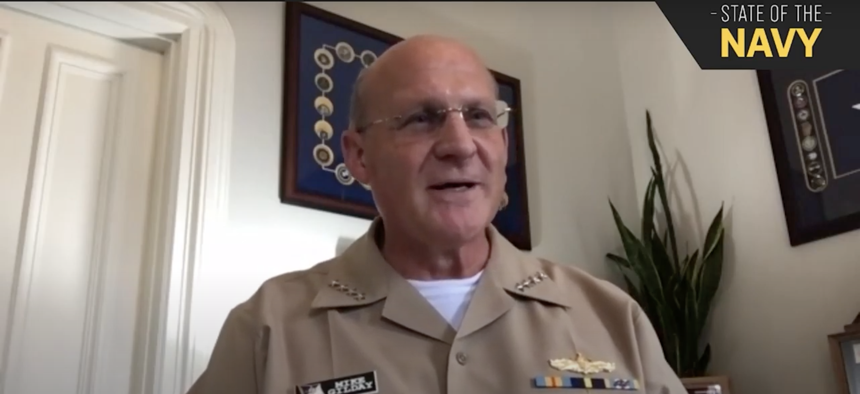
Adm. Michael Gilday speaks at the State of the Navy event on Oct. 13. Defense One
Chief of Naval Operations Outlines Future for Drones, Minicarriers
The fleet may need fewer large aircraft carriers but more ships that can carry aircraft.
The U.S. Navy may need fewer large Nimitz-class aircraft carriers in the future, but that doesn’t necessarily mean fewer ships that can carry aircraft, Chief of Naval Operation Adm. Michael Gilday said in an interview with Defense One on Tuesday. Light aircraft carriers or ships that can serve as small carriers wouldn’t necessarily look like big super carriers from the past, in part because new smaller drones will provide some of the capability that today you only find in carrier air wings.
“Light carriers might more aptly be named the ‘aviation combatant of the future’,” Gilday said in his first public remarks about the 25-year fleet plan unveiled by Defense Secretary Mark Esper last week. Dubbed “Battle Force 2045,” the plan calls for “eight to 11” large-deck carriers, down from today’s 11.
“The time range here is 2045 so, whether or not an aviation platform of the future looks like the Gerald R. Ford or the Nimitz class, that’s questionable,” Gilday said during the "State of the Navy" event, the last in Defense One's State of Defense series.
Of course, medium-sized drones aren’t going to replace the strike capability of large fighter jets but they can, perhaps, take over more of the intelligence, surveillance, reconnaissance and targeting functions roles that carrier-based aircraft provide today. All this “allows us to do much deeper analysis in terms of what type of functions, in a distributed maritime fight, might we want a smaller aviation combatant to do,” said Gilday, listing ISR as a gap. One question is, he said, “Can we close that gap with something smaller than a super carrier?”
Esper had also noted the need to develop unmanned ship-based aircraft, including fighters, aerial refueling, airborne early warning, and electronic attack aircraft.
In 2015, the Defense Advanced Research Projects Agency, working with the Navy, awarded Northrop Grumman a $93 million contract to develop a 40-foot drone that could take off from the deck of a ship like a helicopter but also fly like a fixed-wing aircraft. Dubbed the Tactically Exploited Reconnaissance Node, or TERN, the project made it through phase three of development but has yet to see deployment.
Sam Tangredi, a professor of national, naval and maritime strategy at the Center for Naval Warfare Studies at the U.S. Naval War College, said that relying on smaller mini carriers to perform the role of larger carriers was feasible. “The question is the upfront cost of developing these systems. Before we build a carrier capable of doing that we need to build the unmanned aircraft, figure out how to control them over long distances under battlefield conditions.”
Jill Rough, a distinguished visiting fellow at the Center for Security Policy Studies at George Mason University, said, “The data networks, proper command and control… that’s your limiting factor, not the actual unmanned aircraft.”
Gilday said that the Navy “might” at some point seek to integrate surface-to-air missiles on the decks of robotic self-steering ships like the Sea Hunter, but that integrating communications and electronic warfare functions “could be vital to us as well.”




